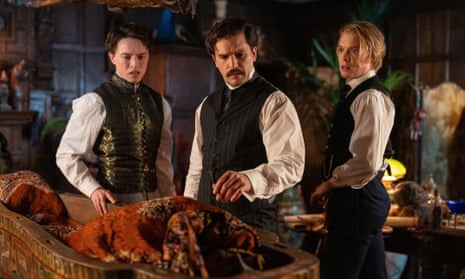As the days grow shorter and the chill of December seeps into the bones, there’s no better antidote to the saccharine glow of fairy lights and mulled wine than a proper ghost story. For over half a century, the BBC’s A Ghost Story for Christmas has been the antidote to festive cheer, delivering tales of spectral unease that linger long after the credits roll. This year, on Christmas Eve 2025, the tradition returns with a shiver-inducing adaptation that promises to redefine holiday horrors: The Room in the Tower. Penned and helmed by the inimitable Mark Gatiss, this 30-minute gem adapts E.F. Benson’s 1912 short story of the same name, transforming a century-old nightmare into a modern meditation on dread, inevitability, and the thin veil between sleep and waking terror.
At its heart is Roger Winstanley, a young man whose life has been shadowed by a recurring dream for fifteen long years. Since boyhood, Roger has been tormented by visions of Aswarby Hall, a sprawling country estate where he’s a guest among a peculiar family—the Medhams. There’s Mrs. Medham, with her vacant eyes and forced smiles; her husband, a bumbling figure lost in his own fog; and their daughter, a silent wraith who drifts through the corridors like smoke. But it’s the room in the tower that chills the blood—a cavernous chamber at the top of the house, its walls papered in crimson, dominated by a massive four-poster bed. In the dream, Roger is always assigned that room, and as midnight tolls, a figure emerges from the shadows: a woman with a face like a skull, her mouth smeared with fresh blood, her eyes gleaming with vampiric hunger. She lunges, and Roger wakes—sweating, heart pounding, but safe. Until one Christmas invitation from the real Mrs. Medham arrives, bearing the fateful words: “I have given you the room in the tower.”

Gatiss, the mastermind behind this spectral revival, has long been the torchbearer for the anthology’s modern era. With eight entries under his belt, he’s woven a tapestry of unease from the likes of M.R. James, Arthur Conan Doyle, and now Benson—a departure from his usual Jamesian fixations that fans are buzzing about. “I’ve always wanted to adapt the great E.F. Benson’s ghost stories, and this is one of his chilling best,” Gatiss enthused upon the October announcement. “I’m also very grateful to have been able to continue the most Christmassy of Christmas traditions. The Room in the Tower has been prepared for you—and with Tobias Menzies and the legendary Dame Joanna Lumley to boot!” His vision transplants the inter-war 1920s setting to a fog-shrouded English countryside, where the opulence of the Jazz Age masks something rotten. Filmed at the majestic Cobham Hall in Kent—a Tudor manor with its own whispers of hauntings—the production captures the creak of ancient floorboards and the flicker of candlelight against tapestries, evoking the claustrophobia of a house alive with malice.
Tobias Menzies, fresh from his Emmy-winning turn as Prince Philip in The Crown and the high-octane drama of F1, embodies Roger with a quiet unraveling intensity. At 51, Menzies brings a world-weary gravitas to the role, his sharp features and piercing gaze making every sidelong glance at a doorway feel like a prelude to doom. Roger’s dreams aren’t mere subconscious fluff; they’re etched into his psyche, forcing him to question his sanity as the line between reverie and reality frays. Menzies, no stranger to the supernatural after roles in Outlander and The Night Manager, has spoken of the thrill in a recent interview: “It’s that slow burn of dread—knowing what’s coming but powerless to stop it. Mark’s script nails that inevitability.” Opposite him, as the enigmatic Mrs. Medham, is the indomitable Joanna Lumley, 79 and still a force of nature. The Absolutely Fabulous icon, whose career spans The New Avengers to Motherland, infuses the matriarch with a brittle elegance—think a porcelain doll cracked by unseen forces. Her smile doesn’t reach her eyes, and in quiet moments, Lumley’s voice drops to a hush that sends gooseflesh racing. “Joanna brings this otherworldly poise,” Gatiss noted. “She’s the perfect vessel for Benson’s subtle horrors.”
Rounding out the ensemble is a trio of talents primed for spectral mischief. Nancy Carroll, the poised sleuth of Father Brown and a Crown alumna, slips into the role of the Medham daughter with an ethereal detachment that hints at secrets long interred. Ben Mansfield, known for his brooding constable in Endeavour and the mystical Sister Boniface Mysteries, plays the son—a figure whose joviality feels like a mask over madness. And then there’s Polly Walker, Gatiss’s recent collaborator from the murder-mystery series Bookish, stepping in as a family confidante whose warmth belies a sharper edge. Walker, a veteran of Rome and Bridgerton, reunites with Gatiss here, her husky timbre and commanding presence adding layers to the household’s unraveling dynamic. This star-studded lineup isn’t just window dressing; each performance amplifies the story’s psychological knife-edge, turning familial politeness into a prelude to the uncanny.
To grasp the resonance of The Room in the Tower, one must delve into its literary progenitor. Edward Frederic Benson, or E.F. as he’s affectionately known, was a polymath of Edwardian letters—archaeologist, novelist, and chronicler of the supernatural. Born in 1867 to the Archbishop of Canterbury, Benson grew up in the rarefied air of Wellington College and Cambridge, where he honed a prose style as crisp as a winter frost. His ghost stories, collected in volumes like The Room in the Tower (1912), stand apart from the Gothic excesses of his contemporaries. Where M.R. James favored scholarly apparitions and creeping unease, Benson’s specters are intimate, almost domestic—vampiric entities that infiltrate the everyday, turning the hearth into a hunting ground. The titular tale, first published in The Pall Mall Magazine, draws from Benson’s own fascination with the subconscious, influenced by the emerging Freudian theories of the era. It’s a vampire story without fangs, where the horror lies not in gore but in predestination: the dream as prophecy, the invitation as executioner’s warrant.
Benson’s world was one of privilege laced with peril—the country house party as microcosm for imperial anxieties, where the old order crumbles under nocturnal visitations. Roger, a stand-in for the modern everyman, grapples with a curse that defies rational explanation, echoing the era’s flirtation with spiritualism. Gatiss, ever the adapter’s alchemist, honors this blueprint while infusing contemporary shadings. Expect subtle nods to post-war trauma—the Medhams as faded gentry clinging to illusions—and a visual lexicon that Gatiss has perfected: Dutch angles in dimly lit halls, shadows that stretch like accusatory fingers, and a sound design where silence is the true monster. Produced by Isibéal Ballance for Adorable Media, under BBC Arts commissioning editor Mark Bell, the film clocks in at a taut half-hour, leaving viewers with that hollow ache of a tale too perfectly resolved.
The A Ghost Story for Christmas strand itself is a cornerstone of British televisual folklore, born in 1971 from the mind of Laurence Scarman and producer Rosemary Hill. Inspired by the Dickensian tradition of yuletide hauntings—think A Christmas Carol‘s Marley rattling chains—the series kicked off with The Stolen Ghost, but it was M.R. James adaptations like Whistle and I’ll Come to You (1968, starring Michael Hordern) that cemented its legacy. The originals, helmed by directors like Lawrence Gordon Clark, were low-budget marvels: fog machines in draughty abbeys, actors in ill-fitting greatcoats, and scores that whispered like wind through eaves. By the 1980s, the anthology waned, but Gatiss resurrected it in 2010 with A Warning to the Curious, a pitch-perfect homage that blended archival footage with new chills.
Gatiss’s tenure has been a renaissance. The co-creator of Sherlock and Dracula, he’s a self-professed “ghost story obsessive,” curating annual dreads with the zeal of a Victorian collector. His pantheon includes The Tractate Middoth (2013), a Jamesian library labyrinth; Martin’s Close (2019), a witch-trial fever dream; Count Magnus (2022), with its cursed reliquary; and last year’s Woman of Stone, an E. Nesbit tale of vengeful statuary that critics hailed as “a deliciously macabre morsel.” Lot No. 249 (2023) veered into Doyle territory with a mummy’s curse, featuring Kit Harington and a pre-Wicked Ariana Grande in a blink-and-miss cameo. Each installment adheres to the format: standalone, period-precise, and unsparing in its supernatural logic. Gatiss’s touch? A wry humor amid the horror, like a polite specter offering tea before the throat-slitting. “These stories remind us why we love Christmas,” he once said. “The dark half of the year, when the veil thins and the dead draw near.”
Fan fervor for The Room in the Tower erupted with the October reveal, flooding X with speculation and spine-tingling memes. “Gatiss branching to Benson? Finally, some vampiric bite to the holidays,” tweeted journalist Will Hazell, echoing a sentiment rippling through threads. Bleeding Cool hailed it as “a victory for the slow-burn scare,” while Radio Times shared first-look images of Lumley in lace, her silhouette against a tower window like a silhouette from a Hammer Horror poster. On Reddit’s r/ghoststories, users dissected Benson’s lore: “That blood-smeared mouth—Gatiss will make it visceral without a drop spilled.” Japanese fans, via @MarkGatissJp, buzzed about the global reach, and even skeptics admitted the cast’s pull. One viral post quipped, “Lumley as a haunted hostess? Sign me up for eternal damnation.” With airdate looming on BBC Two and iPlayer, watch parties are forming from London pubs to virtual Zoom haunts, proving the anthology’s enduring grip.
Yet The Room in the Tower transcends mere seasonal spook. It’s a parable for our fractured times: the inescapable pull of the past, the horror of knowing your fate and marching toward it anyway. In an age of doom-scrolling and collective dread, Benson’s dream-vision feels prophetic—reminding us that some rooms we enter not by choice, but by the inexorable tug of what we’ve always feared. Gatiss, with his ensemble of luminaries, doesn’t just adapt; he resurrects, inviting us to huddle by the fire as the tower clock strikes twelve.
So, as stockings hang and carols fade, dim the lights and steel your nerves. The Room in the Tower isn’t content to rattle chains; it creeps into your subconscious, leaving you to wonder if that creak on the stairs was the wind—or an invitation. In Gatiss’s hands, Christmas isn’t merry; it’s mercilessly, memorably haunted.





